Poori Masala is a traditional South Indian curry made with soft, boiled potatoes cooked in a lightly spiced and flavorful onion-based gravy. It’s most commonly served with soft, fluffy, golden pooris, making it a much-loved comfort meal across households.
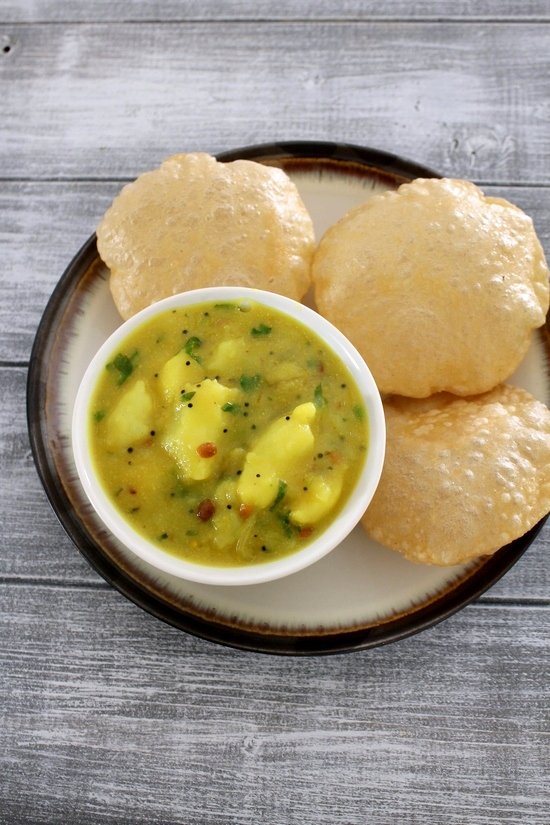
In this simple potato curry, green chilies are the sole source of heat. You can easily modify the level of spiciness to match your personal taste. I typically use just one green chili, which lends a gentle, medium warmth, perfect for those who prefer a subtle kick without overpowering the dish.
Poori with potato masala is a combination that never goes out of style. At our home, it’s a cherished treat we enjoy occasionally. Due to its rich, filling nature, it’s not part of our daily breakfast anymore. Instead, I love preparing it on weekends when we can truly savor it without rushing.
This Poori Masala dish is undeniably carb-rich and indulgent. After enjoying a plateful, you’re bound to feel full and satisfied, making it ideal for a slow-paced, relaxed weekend brunch or lunch. Although it’s traditionally served with puffed pooris, this potato masala pairs beautifully with soft rotis or flaky parathas. It also makes a delicious and filling side dish when paired with dosa for a variation. Its mildly spiced, comforting taste makes it a great addition to any Indian bread-based meal.
Ingredients for Poori Masala:
For Potato Masala:
- Potatoes – 4 small or around 2½ cups: Boil the potatoes until fork-tender, peel off the skin, and mash them roughly. You can leave a few small chunks for added texture in the curry.
- Besan (Gram Flour) – 2 teaspoons: Mix the gram flour in 2 tablespoons of water to make a smooth, lump-free slurry. This helps thicken the curry and gives a nice body to the masala.
- Cooking Oil – 2 tablespoons: Use any neutral oil such as sunflower or vegetable oil to sauté the spices and aromatics.
- Mustard Seeds – ½ teaspoon: Add to hot oil at the beginning to release their nutty aroma and start the tempering process. Let them crackle for that signature South Indian flavor.
- Chana Dal (Split Bengal Gram) – ½ teaspoon: Adds a slight crunch and nutty taste. Make sure it’s slightly golden before adding the next ingredients.
- Urad Dal (Split, skinless black gram) – ½ teaspoon: Often paired with chana dal in South Indian tempering, this adds texture and enhances flavor.
- Green Chili – 1 large, finely chopped: This is the only source of heat in the dish. Adjust the quantity depending on your spice preference.
- Curry Leaves – 1 sprig (8–10 leaves): These fresh leaves add a burst of aroma and authentic taste to the dish.
- Red Onion – ½ cup, thinly sliced: When sautéed, they add a mild sweetness and depth to the gravy.
- Salt – to taste: Add as needed to suit your taste and enhance the overall flavor of the dish.
- Water – 1½ cups: Helps create a light, gravy-like consistency.
- Fresh Coriander Leaves – 2 tablespoons, chopped: Stir in at the end for freshness and color.
- Lemon Juice – 1 teaspoon: Adds a hint of tanginess and balances the flavors beautifully.
Step-by-Step Instructions:
1) Begin by boiling the potatoes. Rinse the potatoes thoroughly under running water. Place them in a pressure cooker and pour in enough water to fully submerge them. Close the lid securely and attach the whistle. Cook the potatoes for about 2 to 3 whistles on medium heat. The cooking time may vary slightly depending on the size and type of potatoes used.
2) Allow the pressure to release naturally. Once the cooker cools down and the pressure drops on its own, carefully open the lid. Take out the boiled potatoes and set them aside to cool until they’re warm and easy to handle.
3) While the potatoes are cooling, start multitasking. Prepare your poori dough in a separate bowl and let it rest. Simultaneously, take 2 teaspoons of gram flour (besan) in a small bowl, add 2 tablespoons of water, and mix until you get a smooth, lump-free paste. Keep this aside for later.
4) Once the potatoes are warm enough, begin peeling. Remove the skins by hand or with a peeler. Ensure all the skin is discarded.

5) Break the potatoes using your hands. Roughly crumble them—don’t mash too finely. It’s okay to have uneven pieces.
6) Texture is key in this dish. Some bits should be mashed to help thicken the curry, while larger chunks add a nice bite and body to the gravy.

7) Warm oil in a heavy-bottomed pan or kadai over medium to low heat. Once hot, add mustard seeds and let them crackle and release their aroma.
8) Add chana dal (split Bengal gram).

9) Sauté the chana dal gently. Stir frequently until the lentils turn golden brown. This adds a crunchy texture and nutty flavor.
10) Now, add the urad dal (split black gram).

11) Sauté the urad dal just like chana dal. Stir continuously to avoid burning, and cook until light golden in color.
12) Add curry leaves and finely chopped green chilies. Sauté for about a minute until fragrant. Be careful as curry leaves may splutter.

13) Stir in turmeric powder. This gives the masala its signature yellow hue and earthy aroma.
14) Immediately add the thinly sliced onions along with a pinch of salt. The salt helps the onions cook faster by drawing out moisture.
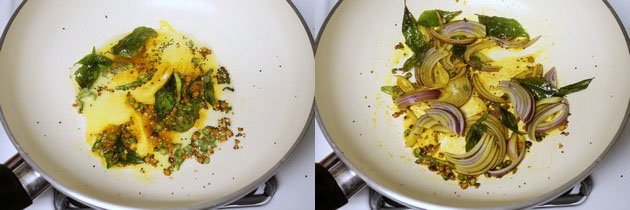
15) Cook the onions until soft and translucent. Stir occasionally to ensure even cooking and prevent burning.
16) Pour in the measured water (about 1½ cups). This forms the base of the gravy.

17) Add the prepared besan (gram flour) mixture. Stir the gram flour mixture again before pouring it in, as the flour may have settled at the bottom.
18) Mix thoroughly to avoid lumps. This step helps thicken the gravy while adding a subtle nutty flavor.
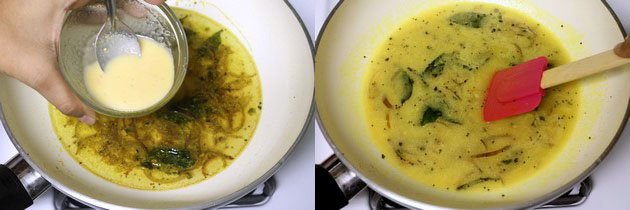
19) Bring the mixture to a gentle boil. Once it starts bubbling, lower the heat and let it simmer for about 5 minutes to let the flavors blend.
20) Add the crumbled potatoes. Stir them in so they combine well with the onion-spice mixture.

21) Simmer the curry for another 4–5 minutes. During this time, the potatoes absorb the flavors, and the gravy reaches a thicker consistency.
22) Check the consistency of the masala. If it looks too thick, feel free to add a splash of hot water and mix. Once done, turn off the heat.
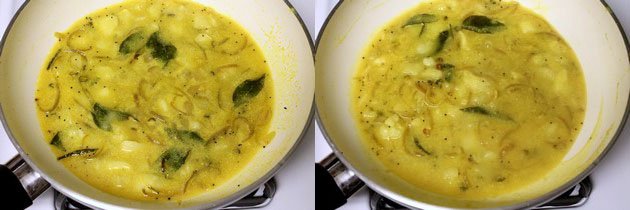
23) Add freshly chopped coriander leaves and a squeeze of lemon juice. This enhances the dish with a fresh, zesty touch that helps offset its rich and hearty flavors.
24) Give everything a final mix, and your potato masala is ready to serve.
25) Prepare the pooris fresh just before serving. Pair the freshly puffed, hot pooris with the warm and spiced potato masala for a satisfying and cozy meal.
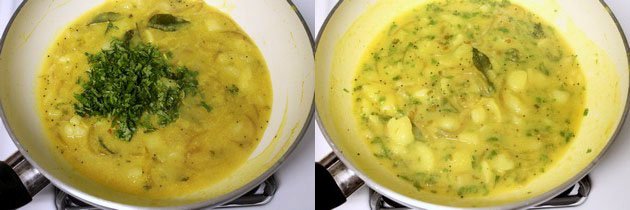
Serving suggestions For Poori Masala:
1. The Classic Combo – Poori & Masala Magic:
The most traditional and beloved way to enjoy this South Indian-style Poori Masala is with freshly fried, golden puffed pooris. The crisp yet soft texture of the poori pairs perfectly with the smooth, mildly spiced potato curry.
For an even more indulgent experience, serve it alongside a small bowl of coconut chutney or a tangy mango pickle. These sides add a contrasting zing that complements the richness of the masala beautifully. It’s a classic morning or brunch favorite that evokes a sense of nostalgia and warmth with every delicious mouthful.
2. With Paratha or Roti – A Fusion Favorite:
Looking for a North-South India fusion? Swap pooris with flaky parathas or soft phulkas. The Poori Masala works wonderfully as a dry or slightly moist curry with rotis, making it a great option for those avoiding deep-fried foods. It’s equally satisfying, lighter on the stomach, and easy to prepare on busy weekdays. You can even spread a layer of this masala inside a roti, roll it up, and serve it as a masala wrap—ideal for kids and adults alike.
3. Stuffed Dosa – A Twist on Masala Dosa:
Got some leftover poori masala? Transform it into a stuffing for crispy dosas. Once the dosa is cooked on one side, layer the potato masala evenly on top, fold it over, and serve hot with sambar and coconut chutney. This instantly turns a simple breakfast into a restaurant-style masala dosa meal at home. You can even enhance it with a sprinkle of chopped onions or grated cheese for a creative twist.
4. As a Hearty Side Dish – Beyond Breakfast:
This Poori Masala isn’t limited to breakfast alone. Serve it as a side with other South Indian staples like lemon rice, tamarind rice, or even curd rice for a wholesome lunch or dinner. The soft texture and gentle flavors complement rice-based meals and make a lovely contrast to tangy or spicy dishes.
5. Perfect for Lunchboxes – Easy to Pack, Easy to Eat:
Poori masala also makes a wonderful lunchbox meal. Just pack it with chapatis or parathas, and it stays fresh for hours. Since it’s not overly spicy or messy, it’s a great option for kids’ tiffin boxes or office lunches. You can even stuff it into sandwich bread or make rolls for a quick grab-and-go meal.

Expert Tips for Making the Best Poori Masala
1. Use the right type of potatoes:
Starchy potatoes like Russet or Indian aloo varieties work best for this dish. They crumble easily and help thicken the gravy, giving the masala a perfect consistency.
2. Don’t over-mash the potatoes:
Keep the texture slightly chunky. This gives body and bite to the dish instead of making it overly smooth or pasty.
3. Balance the flavors:
Taste as you go! Adjust salt, green chili, and lemon juice at the end. The lemon adds brightness, while the chilies add depth—balance is key to make the masala sing.
4. Enhance the aroma with fresh curry leaves:
Curry leaves are essential in South Indian cooking and bring a distinct aroma. Always add them to hot oil to release their full flavor.
5. Besan (gram flour) slurry matters:
The gram flour thickens the gravy, giving it a smooth, velvety texture. Be sure to whisk the slurry well to avoid lumps and stir it just before adding, as it settles quickly.
